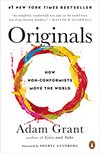
Saved by Rahlyn and
Originals: How Non-Conformists Move the World

Saved by Rahlyn and
liking continues to increase as people are exposed to an idea between ten and twenty times, with additional exposure still useful for more complex ideas. Interestingly, exposures are more effective when they’re short and mixed in with other ideas, to help maintain the audience’s curiosity. It’s also best to introduce a delay between the presentatio
... See morewe often undercommunicate our ideas. They’re already so familiar to us that we underestimate how much exposure an audience needs to comprehend and buy into them. When Harvard professor John Kotter studied change agents years ago, he found that they typically undercommunicated their visions by a factor of ten.
At the third meeting of the board, Griscom reversed his approach, opening with a candid discussion of everything that was going wrong with the company and what was keeping him up at night. Although this tactic might be familiar in a debate, it was highly unconventional for an entrepreneur. Board members, though, responded much more favorably than t
... See moreWhen people presented drawbacks or disadvantages, I would become an ally. Instead of selling me, they’ve given me a problem to solve.”
By acknowledging its most serious problems, he made it harder for investors to generate their own ideas about what was wrong with the company. And as they found themselves thinking hard to identify other concerns, they decided Babble’s problems weren’t actually that severe.
Originality is not a fixed trait. It is a free choice. Lincoln wasn’t born with an original personality. Taking on controversy wasn’t programmed into his DNA; it was an act of conscious will. As the great thinker W. E. B. DuBois wrote, “He was one of you and yet he became Abraham Lincoln.”
The sign on the left had no effect whatsoever. The sign on the right made a significant difference: merely mentioning patients instead of you led medical professionals to wash their hands 10 percent more often and use 45 percent more soap and gel.
For the next two hours, the executives worked in groups, pretending to be one of Merck’s top competitors. Energy soared as they developed ideas for drugs that would crush theirs and key markets they had missed. Then, their challenge was to reverse their roles and figure out how to defend against these threats.*
“The greatest communicators of all time,” says communication expert Nancy Duarte—who has spent her career studying the shape of superb presentations—start by establishing “what is: here’s the status quo.” Then, they “compare that to what could be,” making “that gap as big as possible.”